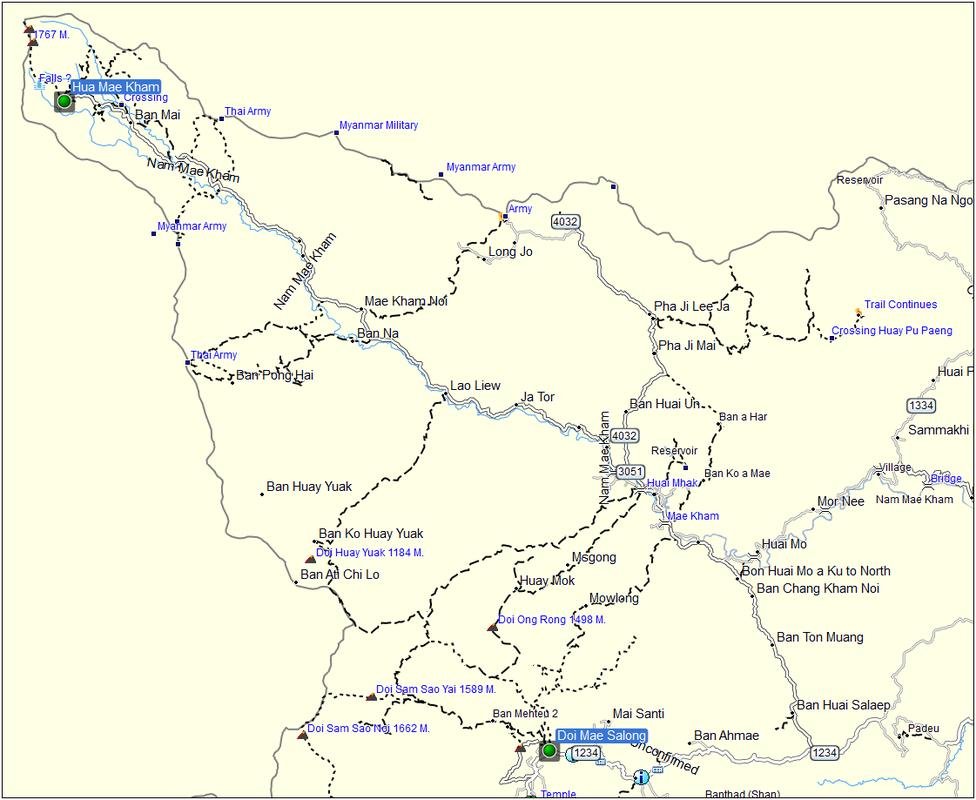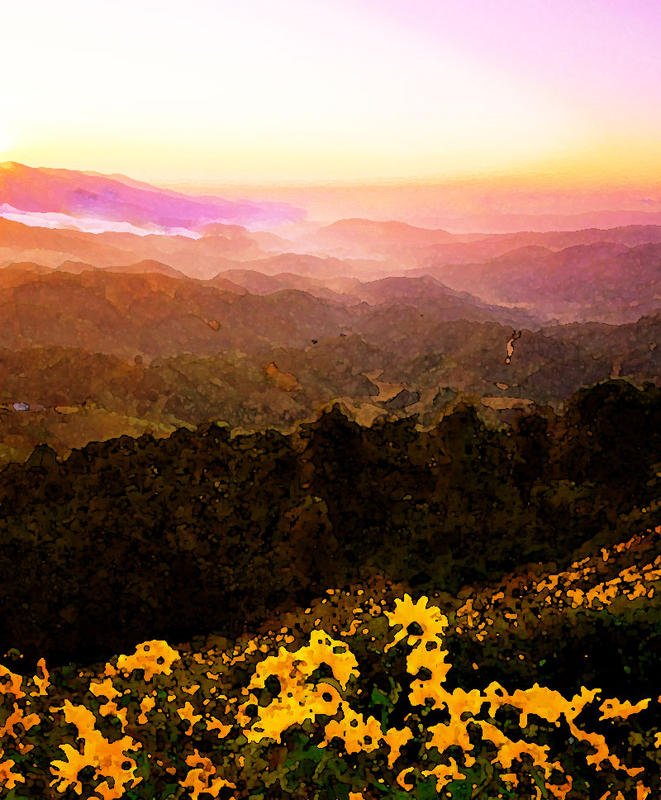Lone Rider
Blokes Who Can
A trip to remote Hua Mae Kham north-west of Doi Mae Salong and Thoed Thai
After having slaved behind the computer for many days and nights updating the GPS maps, I was in need of some fresh air and decided to head to the mountains in the north with no fixed plan other than to see a few new things as well as re-visit others. I was not really in the mood to take a lot of pictures so I will use also some pictures I took this trip as well as others taken on previous trips to the same area.
First stop was Tha Ton where I went to have another look at Wat Tha Thon (TEMPLES) also known as Wat Luang. I was not really there to see the temple but rather the big pagoda also known as CHEDI KAEW PAGODA up the mountain from the temple (see here for pictures taken during the construction of this pagoda: Chedi Kaew Pagoda 1 and Chedi Kaew Pagoda 2.



On one of the levels of the pagoda, plaques had been inserted which showed each of the years of the 12 year cycle of the Chinese zodiac each with a different temple and appropriate prayers for that year.
The Shēngxiào (Chinese: 生肖), also known in English as the Chinese zodiac, is a scheme, and a systematic plan of future action, that relates each year to an animal and its reputed attributes, according to a 12-year mathematical cycle. It remains popular in several East Asian countries, such as China, Vietnam, Korea, Taiwan and Japan. In Chinese astrology the animal signs assigned by year represent what others perceive you as being or how you present yourself. It is a common misconception that the animals assigned by year are the only signs and many western descriptions of Chinese astrology draw solely on this system. In fact, there are also animal signs assigned by month (called inner animals), by day (called true animals) and hours (called secret animals). While a person might appear to be a Dragon because they were born in the year of the Dragon, they might also be a Snake internally, an Ox truly, and a Goat secretively.(Chinese zodiac - Wikipedia, the free encyclopedia)




As it was getting late I decided to stay the night in Tha Ton - this time at the Apple House Resort (N20.06104 E99.36348) and had dinner at the Marble Restaurant (opposite the 7-11 at N20.05952 E99.36124). I had a look at the new Jack's Coffee at N20.05837 E99.36059 but the noisy Muay Tai boxing match shown on the telly in the restaurant did not appeal to me. Must admit though that the food and the pies and cakes looked good.

Bungalows at the Apple House Resort
The next day I decided to go to Hua Mae Kham to visit Wat Hua Mae Kham (Border Temple) while along the way taking in some temples and stupas I had spotted before but never had taken the time to have a closer look.
First of these was a new stupa in Ban Mai Nok on the Mae Kok River


The road to Mae Suai (Rd 3037/3044) as seen from the new stupa.
Wat Mueang Ngam Tai with a big new stupa (N20.06893 E99.50330) just off Rd 3010


Views along the way to Doi Mae Salong with the hill rice starting to ripen in some of the fields





Phra Borommathat Chedi Srinagarindra Sathit Maha Santi Khiri



The new chedi east of Doi Mae Salong as seen from as seen from Phra Borommathat Chedi Srinagarindra Sathit Maha Santi Khiri



The roads out of Doi Mae Salong are steep and this truck went a bit to fast and landed in the bushes
Views along the roads to Hua Mae Kham


The roads near Hua Mae Kham were badly potholed and in some places showed deep ruts in the pavement while the backroads in the village were decidedly narrow


The sunflowers are expected to be in full bloom in November and will then form the background of the "Bua Thong and Tribal Culture Festival" which normally is held during the 3rd weekend of November.

Picture copied from: 2 3 Perspective Company
Wat Hua Mae Kham (Border Temple - N20.36148 E99.48266) is located on a hilltop a bit south-east of Ban Hua Mae Kham. The main reason for me to go here was that I had seen this temple in a movie called "Buddha's lost Children" which is basically a movie about Khru Bah Neua Chai Kositto, a former boxer (then known as Samerchai) and now Abbot of Wat Tham Pa Acha Thong (N20.22630 E99.80710) or the "Golden Horse Temple". Wat Hua Mae Kham is/was basically one of the outposts of the Golden Horse Temple during the time Khun Sa was reigning supreme in this area.
Buddha's Lost Children - Buddha's Lost Children is a 2006 documentary film by Dutch director Mark Verkerk. The feature film tells the story of Khru Bah Neua Chai Kositto, a Buddhist monk who has dedicated his life to orphaned children in the Golden Triangle area of Thailand.
The whole movie can be found here: Buddhas Lost Children - YouTube while the trailer for the movie is here: Trailer - Buddha's Lost Children - YouTube





The Buddha has weathered quite bit as it is at the moment standing in the open air - the 4 monks in attendance at the wat told me that they were going to construct a new shelter for the Buddha as the old shelter apparently had burnt down. In the movie trailer at 1.30 you can see the same Buddha during better days.

After having slaved behind the computer for many days and nights updating the GPS maps, I was in need of some fresh air and decided to head to the mountains in the north with no fixed plan other than to see a few new things as well as re-visit others. I was not really in the mood to take a lot of pictures so I will use also some pictures I took this trip as well as others taken on previous trips to the same area.
First stop was Tha Ton where I went to have another look at Wat Tha Thon (TEMPLES) also known as Wat Luang. I was not really there to see the temple but rather the big pagoda also known as CHEDI KAEW PAGODA up the mountain from the temple (see here for pictures taken during the construction of this pagoda: Chedi Kaew Pagoda 1 and Chedi Kaew Pagoda 2.



On one of the levels of the pagoda, plaques had been inserted which showed each of the years of the 12 year cycle of the Chinese zodiac each with a different temple and appropriate prayers for that year.
The Shēngxiào (Chinese: 生肖), also known in English as the Chinese zodiac, is a scheme, and a systematic plan of future action, that relates each year to an animal and its reputed attributes, according to a 12-year mathematical cycle. It remains popular in several East Asian countries, such as China, Vietnam, Korea, Taiwan and Japan. In Chinese astrology the animal signs assigned by year represent what others perceive you as being or how you present yourself. It is a common misconception that the animals assigned by year are the only signs and many western descriptions of Chinese astrology draw solely on this system. In fact, there are also animal signs assigned by month (called inner animals), by day (called true animals) and hours (called secret animals). While a person might appear to be a Dragon because they were born in the year of the Dragon, they might also be a Snake internally, an Ox truly, and a Goat secretively.(Chinese zodiac - Wikipedia, the free encyclopedia)




As it was getting late I decided to stay the night in Tha Ton - this time at the Apple House Resort (N20.06104 E99.36348) and had dinner at the Marble Restaurant (opposite the 7-11 at N20.05952 E99.36124). I had a look at the new Jack's Coffee at N20.05837 E99.36059 but the noisy Muay Tai boxing match shown on the telly in the restaurant did not appeal to me. Must admit though that the food and the pies and cakes looked good.

Bungalows at the Apple House Resort
The next day I decided to go to Hua Mae Kham to visit Wat Hua Mae Kham (Border Temple) while along the way taking in some temples and stupas I had spotted before but never had taken the time to have a closer look.
First of these was a new stupa in Ban Mai Nok on the Mae Kok River


The road to Mae Suai (Rd 3037/3044) as seen from the new stupa.
Wat Mueang Ngam Tai with a big new stupa (N20.06893 E99.50330) just off Rd 3010


Views along the way to Doi Mae Salong with the hill rice starting to ripen in some of the fields





Phra Borommathat Chedi Srinagarindra Sathit Maha Santi Khiri



The new chedi east of Doi Mae Salong as seen from as seen from Phra Borommathat Chedi Srinagarindra Sathit Maha Santi Khiri



The roads out of Doi Mae Salong are steep and this truck went a bit to fast and landed in the bushes
Views along the roads to Hua Mae Kham


The roads near Hua Mae Kham were badly potholed and in some places showed deep ruts in the pavement while the backroads in the village were decidedly narrow


The sunflowers are expected to be in full bloom in November and will then form the background of the "Bua Thong and Tribal Culture Festival" which normally is held during the 3rd weekend of November.

Picture copied from: 2 3 Perspective Company
Wat Hua Mae Kham (Border Temple - N20.36148 E99.48266) is located on a hilltop a bit south-east of Ban Hua Mae Kham. The main reason for me to go here was that I had seen this temple in a movie called "Buddha's lost Children" which is basically a movie about Khru Bah Neua Chai Kositto, a former boxer (then known as Samerchai) and now Abbot of Wat Tham Pa Acha Thong (N20.22630 E99.80710) or the "Golden Horse Temple". Wat Hua Mae Kham is/was basically one of the outposts of the Golden Horse Temple during the time Khun Sa was reigning supreme in this area.
Buddha's Lost Children - Buddha's Lost Children is a 2006 documentary film by Dutch director Mark Verkerk. The feature film tells the story of Khru Bah Neua Chai Kositto, a Buddhist monk who has dedicated his life to orphaned children in the Golden Triangle area of Thailand.
The whole movie can be found here: Buddhas Lost Children - YouTube while the trailer for the movie is here: Trailer - Buddha's Lost Children - YouTube





The Buddha has weathered quite bit as it is at the moment standing in the open air - the 4 monks in attendance at the wat told me that they were going to construct a new shelter for the Buddha as the old shelter apparently had burnt down. In the movie trailer at 1.30 you can see the same Buddha during better days.





